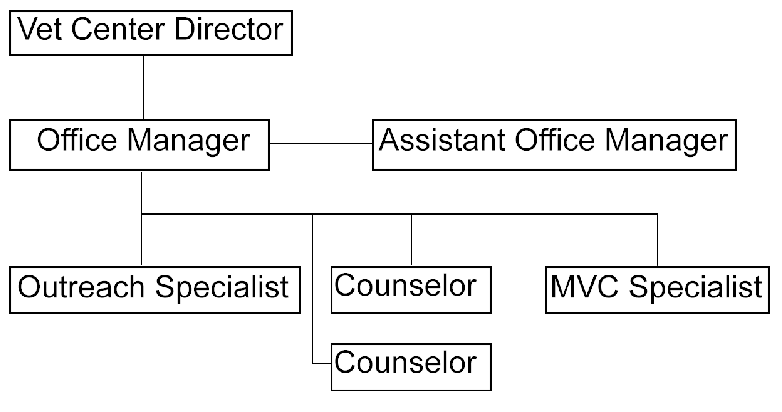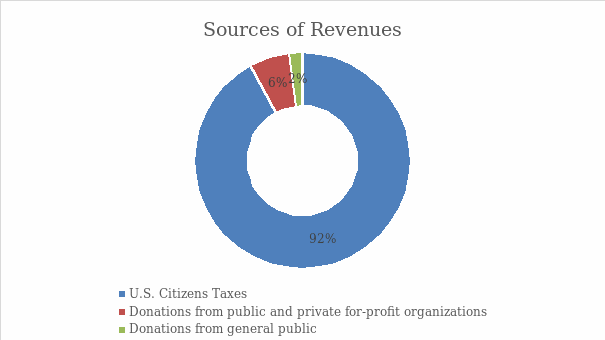Unit Description
Western Oahu Veterans Center is a local branch of the U.S. Department of Veterans Affairs, a governmental agency that aims to provide various types of aid to veterans of U.S. military service. The center’s staff consists of seven employees who work eight hours a day, six days a week. Figure 1 presents an organizational chart for this office.

Mission Statement
“To fulfill President Lincoln’s promise… by serving and honoring the men and women who are America’s veterans” (U.S. Department of Veterans Affairs 2018, par. 1).
Major Activities
The center under discussion is chiefly occupied with outreach tasks, providing consultations and referrals to veterans on a variety of issues including health care, education, home loans, insurance, benefits, pensions, and so forth.
Objective
The main objective is to ensure that every veteran who seeks the council is satisfied with the result of the unit’s work. Representing the larger organization, the vet center serves as a local branch to ensure that veterans in the Western Oahu region receive the support guaranteed by law to all U.S. veterans across the country.
Sources of Revenues for Western Oahu Veterans Center

Table 1. Operational expenditures for fiscal years 2019–2025.
Expected Trends
According to the Defense Manpower Data Center (2018), the numbers of deployed forces are steadily dwindling (cited in Bialik 2018). As a whole, military personnel has been decreasing gradually since the 1990s despite a minor peak around 9/11 (Reynolds and Shendruck 2018). These statistics imply that the number of veterans of military service will inevitably decline, which will mean a diminished demand for veterans center services in the next six years.
This might lead the government to allocate less funding to the U.S. Department of Veterans Affairs, which may consequently lead to decreased spending in local units such as the Western Oahu Veterans Center. Thus, staff reductions due to decreased service demands are possible. In that case, the most significantly affected expenditure categories will probably involve personnel-related expenses.
Also, an increasing tendency to employ robotic units and AI-controlled machinery for military assignments is evident. Thus, Bachman (2018) reported that the Pentagon is aiming to increase the budget for the development of robotic troops and unmanned mechanisms. This trend partially explains the accelerating decline in the numbers of active-duty soldiers in the U.S. Army and eventual veterans. While a minor clientele reduction effect can be expected within six years, long-term consequences could be more substantial. Hence, decreases in workload and the number of personnel could be expected as well as in expenditures for salary and bonuses.
On the other hand, a study by the University of Southern California (2014, par. 1) suggested that life expectancy across the United States is growing steadily; in fact, the number of older adults born between the 1950s and 2000s increased by 4% and will grow up to 20% by 2050. This trend might decelerate the decrease in clientele as well as operational expenditures for the unit due to the increased life expectancy for veterans. Overall, the trends suggest that only minor changes in the upcoming six-year period will affect the expenditures of Western Oahu Veterans Center.
Evaluation
The key areas of the unit’s performance include outreach, consulting, and referrals. The most significant measures of effectiveness for each of those activities are the number of veterans reached, the number of clients satisfied with services, and the number of referrals used.
Outreach Outputs
- The number of veterans reached
- Number of veterans visiting office after outreach
Outreach Outcome
- Percentage of reached veterans who became more knowledgeable of the vet center services
The challenge to measure this outcome is to determine a client’s level of understanding. To address this, specialists employ a clarifying question such as, “Is everything clear to you?”
Consulting Outputs
- Number of veterans consulted.
- Number of veterans consulted over the phone.
- Rate of new veteran and family visitors.
Consulting Outcomes
- Number of veterans who improved their economic circumstances.
- Number of veterans who found support in achieving their goals.
- Number of veterans who received access to affordable housing.
Outcomes are difficult to measure due to the scarcity of veterans themselves reporting their successes. A possible resolution of this problem is to establish follow up visits or calls.
Referrals Outputs
- Rate of referral success (as a proportion of referrals given to referrals used).
- Number of new enrollees in PTSD, Substance Use Disorder, or other available programs.
Referrals Outcomes
- Percentage of veterans recovering from their health issues.
- Percentage of veterans developing meaningful and lasting connections with others.
Measuring outcomes could be problematic as it is not always possible to reach veterans. Presently, the problem is resolved by telephone follow-up, which is only partially effective as well as time-consuming.
Bibliography
Bachman, Justin. 2018. “The U.S. Army Is Turning to Robot Soldiers.” Bloomberg. Web.
Bialik, Kristen. 2018. “Where Are U.S. Active-Duty Troops Deployed?” Pew Research Center (blog).
Reynolds, George, and Amanda Shendruck. 2018. “Demographics of the U.S. Military.” Council on Foreign Relations.
The University of Southern California. 2014. “Americans Are Living Longer.”
U.S. Department of Veterans Affairs. 2018. “About VA.”